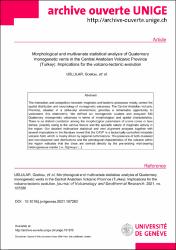| dc.contributor.author | Uslular, Göksu | |
| dc.contributor.author | Le Corvec, Nicolas | |
| dc.contributor.author | Mazzarini, F. | |
| dc.contributor.author | Legrand, D. | |
| dc.contributor.author | Kuşçu, Gonca Gençalioğlu | |
| dc.date.accessioned | 2021-06-10T10:09:34Z | |
| dc.date.available | 2021-06-10T10:09:34Z | |
| dc.date.issued | 2021 | en_US |
| dc.identifier.citation | USLULAR, Göksu, et al. Morphological and multivariate statistical analysis of Quaternary monogenetic vents in the Central Anatolian Volcanic Province (Turkey): Implications for the volcano-tectonic evolution. Journal of Volcanology and Geothermal Research, 2021, no.107280 | en_US |
| dc.identifier.issn | 03770273 | |
| dc.identifier.uri | https://doi.org/10.1016/j.jvolgeores.2021.107280 | |
| dc.identifier.uri | https://hdl.handle.net/20.500.12809/9308 | |
| dc.description.abstract | The interaction and competition between magmatic and tectonic processes mostly control the spatial distribution and morphology of monogenetic volcanoes. The Central Anatolian Volcanic Province, situated in a strike-slip environment, provides a remarkable opportunity to understand this relationship. We defined six monogenetic clusters and analyzed 540 Quaternary monogenetic volcanoes in terms of morphological and spatial characteristics. There is no distinct correlation among the morphological parameters of scoria cones or lava domes, possibly owing to the various factors and the sporadic nature of magmatic activity in the region. Our detailed multivariate statistical and vent alignment analyses together with several implications in the literature reveal that the CAVP is a tectonically-controlled intraplate volcanic field, which is mostly driven by regional deformations. The presence of both clustered and non-clustered vent distributions and the petrological characteristics of the volcanics within the region indicates that the dikes are derived directly by the pre-existing melt-bearing heterogeneous mantle (i.e., Eğrikuyu monogenetic field) or the independent and short-lived shallow or deep crustal magma reservoirs (i.e., Nevşehir-Acıgöl volcanic field). The local changes in the stress regimes and crustal lithology result in variations of field shape, spatial vent distribution, and vent alignments throughout the region. The triggering mechanisms for the initiation of the Quaternary volcanism in the region can be the lithospheric-scale Central Anatolian fault zone, here considered as an immature rift zone where Erciyes volcanic field is developed and behaves as a possible magmatic transfer zone. Tuz Gölü fault zone as a western border of the so-called rift basin in the region is mostly responsible for the crustal propagation of magma, and the kinematic changes along this fault zone (i.e., strike-slip to normal) mostly shaped the spatial vent distributions and alignments of the clusters in its close proximity (e.g., Hasandağ-Keçiboyduran volcanic field). | en_US |
| dc.item-language.iso | eng | en_US |
| dc.publisher | Elsevier B.V. | en_US |
| dc.relation.isversionof | 10.1016/j.jvolgeores.2021.107280 | en_US |
| dc.item-rights | info:eu-repo/semantics/openAccess | en_US |
| dc.subject | Self-similar clustering | en_US |
| dc.subject | Vent alignment | en_US |
| dc.subject | Central Anatolian Volcanic Province | en_US |
| dc.subject | Monogenetic volcanism | en_US |
| dc.subject | Strike-slip tectonism | en_US |
| dc.title | Morphological and multivariate statistical analysis of quaternary monogenetic vents in the Central Anatolian Volcanic Province (Turkey): Implications for the volcano-tectonic evolution | en_US |
| dc.item-type | article | en_US |
| dc.contributor.department | MÜ, Mühendislik Fakültesi, Jeoloji Mühendisliği Bölümü | en_US |
| dc.contributor.authorID | 0000-0001-9801-6542 | en_US |
| dc.contributor.institutionauthor | Kuşçu, Gonca Gençalioğlu | |
| dc.identifier.volume | 416 | en_US |
| dc.relation.journal | Journal of Volcanology and Geothermal Research | en_US |
| dc.relation.publicationcategory | Makale - Uluslararası Hakemli Dergi - Kurum Öğretim Elemanı | en_US |


















